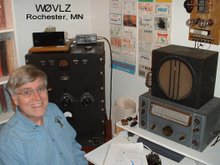Looking over my shack I see a lot of two tube homebrew receivers, mostly regeneratives. It's time for a two IC receiver.
I've been a fan of direct conversion receivers for some time. Unfortunately most of them have left the market but recently my search found the QRPKits / Pacific Antenna 40 mtr Easy Rcvr. While only covering 75KHz of 40 meters the $25 price tag made it sound interesting. If I don't actually use it on the air maybe I can recommend it to a friend of mine as a learning tool and cheap way to listen in to ham QSOs.
My $25 (plus tax and shipping) got me a small plastic bag with all of the parts plus knobs, antenna connector and a 9V battery connector. A battery, antenna and ear phones/buds were all that was needed to put it to use.
I really liked the available on-line manual. It had check-off steps taking you though construction component by component along with construction tips and a troubleshooting guide. It reminded me of some of the Heathkit projects I've built in the long past.
The first step was to inventory the parts. Many of the parts, while discrete pin-in-hole, are really small. In some cases I had to use my phone's camera to blow up part markings in order to read them. I also made use of my digital multimeter to confirm what I was reading.
While an "Easy" receiver, this one still takes care in building. The component locations are all clearly marked but the solder pads are pretty close together in order to all fit on the 3.5" x 2" printed circuit board. I needed to get a sharper tip for my solder iron before I felt I could do a good job without any solder bridges. On the plus side the solder mask was effective.
My Easy Receiver worked when I first powered it up. All I needed to do was set which part of 40 mtrs I wanted to cover. While marketed as half of a QRP CW station I found it works fine as a SSB phone receiver, not as good as a modern transceiver but certainly usable.
The final Easy Receiver packaging is left up to the creativity of the builder. The QRPKits website mentions stacking it with the matching transmitter for a complete 40 mtr QRP station. For now I wanted more of a stand-alone receiver for listening to SSB.
For the "enclosure" I used a scrap of 4x1 as the base with a piece of aluminum attached to it for the front panel. Next, the stock Easy Receiver comes with no power switch. I added one to avoid wear and tear on the 9V battery connector. I also changed out the small knobs provided by QRPKits in order to make it easier to tune SSB signals. Finally, I added a more generic antenna connection. I wish I could have added some sort of bandspread, vernier tuning or a 10 turn pot as suggested by QRPKits. As it is now tuning SSB takes patience and a steady hand.
I've uploaded a demo to you tube. View it
here.
I'm pretty happy with my 40 mtr Easy Receiver. It makes a good loaner that allows someone to get a feel for ham radio. It is also easy to shift down to the CW band so that I can pair it with a similar transmitter and head for a park.










